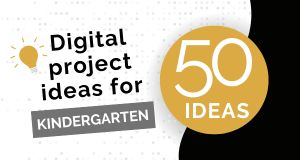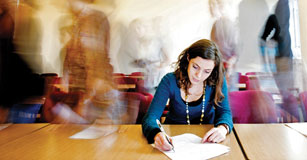5 Ways to Create an Impassioned Classroom
Experimentation lessons from the life of Walt Disney

Every year, teachers get a new mix of learners with unique interests, needs, and relationships. In order to create an environment where all these different learners feel safe and eager to learn, we rely on our ever-growing bag of instructional and interpersonal tricks. This experimentation is crucial to a successful school year.
When Walt Disney learned about a new idea or technology, he jumped in with both feet. He loved trying new things. While not all of his experiments were successful, many did succeed, and some have become legendary. He revolutionized animation, created the first full-length animated film, invented theme parks and designed an Experimental Prototype Community of Tomorrow (EPCOT), his vision of what the future might hold.
Think of your classroom as a living laboratory, a place where you and your students experiment to find the best way to work together and achieve each individual's goals. Through trial and error, guesswork, and experience, you create powerful learning communities.
Here are five things you can do to make your classroom a more passionate learning space, inspired by the life of Walt Disney.
1. Be brave.
"It is a mistake not to give people a chance to learn to depend on themselves while they are young." Walt Disney
We ask our students to try new things all the time, pushing them beyond their comfort zones and asking them to be vulnerable. The tasks we assign may not seem daunting, but that's probably because we've done them before.
Experimentation, and the change that results from it, takes courage. Innovation most often happens when you are pushed out of your comfort zone.
Show your students that you are brave enough to try new things. This will help them see that feeling uncomfortable is not always a bad thing and can encourage them to be brave as they experiment with new ideas and skills. Challenging the status quo, doing what you think is right, believing in yourself, and taking action are ways that you can make magic happen in your classroom.
Empower your students' bravery by giving them the tools and confidence to be self-reliant. Create opportunities for them to be bold and resourceful. Believe in them so much that they have no choice but to believe in themselves. Design learning opportunities for them to step outside of their comfort zones, and cheer them on when they do so.
When a student approaches you with an innovative idea or a question that you didn't expect, take a moment to consider your response. It may have taken a lot of courage to share their questions and ideas aloud. Take a moment to truly consider the question and find a way to make it work.
2. Be relentlessly curious.
Historian Stacia Martin wrote that Walt Disney "wanted to know about everything...everything was interesting to him. He didn't sit back and wait for reports to cross his desk. He was constantly pursuing information by talking to people." Walt Disney would then take the information he acquired through this "relentless curiosity" and put it to effective use.
Keep your eyes and ears open to new possibilities. When you hear an idea that gets your mind buzzing, follow it. Keep your "teacher brain" turned on in everything you do and bring your inspiration into the classroom. Mix and match ideas and practices you like to make a system that works for your students.
Relentless curiosity is the cornerstone of authentic, inquiry-based learning. Cultivate student curiosity by demonstrating your own inquisitiveness, modeling for students how to find inspiration anywhere. Underscore the value of asking great questions. Your example will help them learn to design their own learning opportunities, build real skills, and take ownership of their learning.
3. See how others do it.
Walt Disney made time to visit every part of the studio and his theme park. He spoke to everyone, eager to learn the details about how everything worked.
We live in a world with instant access to an unlimited amount of information; unlike Walt, you don't have to travel coast to coast to talk to people and learn how different things works. The internet is an endless source of blogs, TED Talks, YouTube videos, and Twitter feeds featuring interesting and successful people! Use technology to connect your classroom with people from all over the world. Encourage students to ask questions to satisfy their curiosity, or simply listen to others to find inspiration.
4. Find your passion.
Disney's friend and science fiction author Ray Bradbury once said, "We are all born who we are. Walt was a genetically unique individual who was born to be himself. His job, and ours as well, is to finish the job on Earth that we were created for."
Finding your passion can be absolutely transformative. A former student of mine discovered her passion for poetry when guest poets visited our class. She remembers, "I was not the most confident or open person going into that class, but my teacher did not disregard my talent; she pushed me to pursue it. When she taught me to believe in myself, my life transformed." This student went on to become a nationally recognized spoken word artist.
As educators, we get to introduce young people to things they might not even know they love. When learners see teachers modeling a passion for learning and trying new things, they are empowered to discover their own passions.
When students come to you with an idea they want to share about or try, embrace their passion. Make space for their ideas. Let them explore, experiment, and succeed at school so they can explore different paths in a safe and supportive environment. Make your classroom an environment where students can discover their passions.
5. Take risks.
Walt Disney seemed fearless to others, almost always choosing courage over comfort. Disney's life history is often defined by his numerous successes and the influence of his innovations. The rewards were never without risk; he brought himself and his company to the brink of ruin time and time again. Disney was willing to take risks to make things better.
Instead of basking in the glow of each success, Disney immediately began applying his remarkable imagination and problem solving skills to his next endeavor. Through experience, Disney learned that when he dreamed, believed in himself, and took action, he could create incredible things.
Cultivate an environment where students feel safe to experiment with their passions, ideas, and dreams. When they know they can take risks, they will be open to thinking creatively and explore ways to grow their ideas and abilities.
Share stories of risks with your students. Tell them about when you have taken risks as well as the stories of successful people. Share the stories of former students whose risks yielded interesting results. Celebrate your current students' ideas and efforts when you see them taking risks, and support them as they tackle challenges both big and small.
Only by taking risks and taking action can you make things happen the way you envision. Taking a risk can lead to rewards you dreamed of. Disney said, "Well, after forty-some years in the business, my greatest reward, I think, is that I've had the public appreciate and accept what I've done all these years. That is the great reward."










